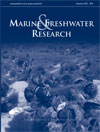Marine and Freshwater Research
Volume 63
Number 1 2012
Removal of stream-side vegetation is a major ecological issue worldwide that alters energy and nutrient availability in streams, for example by reducing leaf litter inputs. We assessed the impact of vegetation clearing, identifying a shift in stream resource availability and nutrient content, with associated flow-on effects for a stream consumer. The research shows that human disturbance can impact ecosystems by altering the relative abundance of different elements.
Behavioural responses to the presence of predators are likely to vary depending on the foraging strategies of both predator and prey. We show that grazing mayflies (which are exposed to fish predation while feeding) show reduced movement and drift rates when fish are present, unlike detritivorous caddisflies (better protected while foraging on decaying organic matter), which do not modify their behaviour.
Percentage of total area protected is often used as a target for marine conservation planning. This was examined at Ningaloo Marine Park and, although 34% is designated as sanctuary zones, some benthic habitats were found to be under-represented in these zones. Further zoning of the park, as well as incremental protection elsewhere, could be guided by the post hoc systematic approach used in these analyses.
The selection of an appropriate growth model is important for estimating the abundance of marine populations. Model selection was based on statistical and biological criteria. The statically optimum growth model was not necessarily biologically plausible. The selection of a model based solely on statistical criteria may mislead estimates on stock abundance and may have implication for the sustainable management of fish stocks.
Understanding the nature and causes of recent climate variability on the Great Barrier Reef, Australia, is fundamental to assessing the impacts of future climate change on this complex ecosystem. We examined the relationship between GBR surface climate and the wider tropical Pacific showing that ENSO events are not a primary driver of inter-annual climate variability on the GBR. This study contributes to understanding the climate drivers likely to impact on this coral reef ecosystem.
Flow often limits the growth of suspended algae in a river, especially in faster flowing rivers, which can have implications for the river’s ecology and its management. However, in the middle reaches of the Daly River (tropical Australia) this was not found to be the case, instead nutrients probably limit the amount of suspended algae in the river. Even in a fast-flowing river, a population of suspended algae can grow in a river.
Parasites are ubiquitous and can have large impacts on their hosts and on the broader ecological community. We demonstrate negative impacts of an invasive parasite on the physiological condition of an ecologically important shrimp host. These negative impacts of this new parasite are likely responsible for recently-documented reproductive failure of the host species, leading to the decline of the host population.
Intertidal soft sediment shores are subject to vertical zonation pressures just like rocky shores, but sand or mudflat profiles are rarely measured. Inexpensive and easy temperature monitoring may allow researchers to tease apart the effects of submersion period on seabed animal communities from other, more visible factors like environmental engineering. In a sheltered New Zealand inlet, height differences of only 100 mm corresponded with important community boundaries.
This study investigates why the formerly abundant mussel reefs in the Firth of Thames, New Zealand have not recovered since overfishing. Using a translocation experiment across a turbidity gradient, the authors showed that adult mussels could survive long-term within their former range. Restoration of mussel reefs and the ecosystem services that they provide may therefore be possible
Giant mud crabs are an important food source throughout the Indo-west Pacific and are widely caught in commercial and subsistence fisheries. We explored the impact of environmental drivers on Australian commercial giant mud crab catches and demonstrated that a large proportion of variation in catch rates is due to rainfall and temperature differences. The findings support the general understanding that estuarine fisheries species depend on freshwater runoff.




